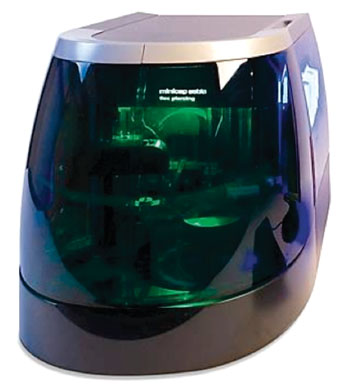Capillary Electrophoresis Evaluated for Hemoglobinopathy Testing
By LabMedica International staff writers
Posted on 26 May 2015
The detection of structural hemoglobin (Hb) variants and thalassemia has become increasingly important in clinical laboratories of all countries with a large influx of immigrants over the past 10 years.Posted on 26 May 2015
Guidelines for hemoglobinopathy screening not only recommend the use of quantitative techniques for thalassemia detection, they also stress the use of a confirmatory method when an Hb variant is detected. In an ideal setting, both techniques can be met by a combination of high-performance liquid chromatography (HPLC) and capillary zone electrophoresis (CZE).

Image: The Minicap Flex Piercing capillary zone electrophoresis system (Photo courtesy of Sebia).
Scientists at the University Hospital Leuven (Belgium) and their colleagues evaluated a suitable stand-alone method for hemoglobinopathy screening of approximately 50 clinical samples a week. The studied the analytical performance of a CZE and set up a comparison with two well-established HPLC methods.
Capillary zone electrophoresis was performed using the Minicap Flex Piercing CZE system (Sebia; Norcross, GA, USA). The instrument is equipped to resuspend, lyse, separate, and analyze whole blood samples for variants collected in ethylenediaminetetraacetic acid (EDTA) tubes. The lysed red cells are electrophoresed in alkaline buffer (pH 9.4) allowing separation to be directed by pH and endosmosis. Detection of eluting hemoglobin species is accomplished using the change in absorbance at 415 nm. CZE does not require daily calibration, but normal HbA and HbA2 migration controls are analyzed daily through each capillary before additional quality control (QC), or patient samples are run to ensure proper charge and function of both capillaries. The two well-established HPLC methods were the Bio-Rad Variant Classic and the Bio-Rad D-10 instruments (Bio-Rad Laboratories; Hercules, CA, USA).
The analytical performance was acceptable for the determination of HbA, HbA2, HbS, and HbF, with an imprecision equal to or less than 2.0%. Method comparison showed a linear correlation for HbA2, HbF, and HbS measurements. Clinical concordance was acceptable when comparing CZE and HPLC. Hb variant presumptive identification was evaluated by analyzing seven samples with confirmed heterogeneous or homogeneous presence of Hb variants: two HbC, one HbD, one HbE and HbA2'. One sample was compound heterogeneous for HbS and HbC. On the Minicap Flex Piercing, a minimal overlap between HbC and HbA2 was found.
The authors concluded that as HPLC methods have the advantage of a great precision in detection of a large number of variants, it has the disadvantage of a complex elution pattern that may be difficult to interpret for many routine chemistry laboratories. The Minicap Flex Piercing showed similar analytical performance compared to previous published work using CZE. As for HPLC, CZE gives only a provisional identification of variant hemoglobins, and confirmation by an alternative method based on a different principle is needed. The study was published in the June 2015 issue of the International Journal of Laboratory Hematology.
Related Links:
University Hospital Leuven
Sebia
Bio-Rad Laboratories














